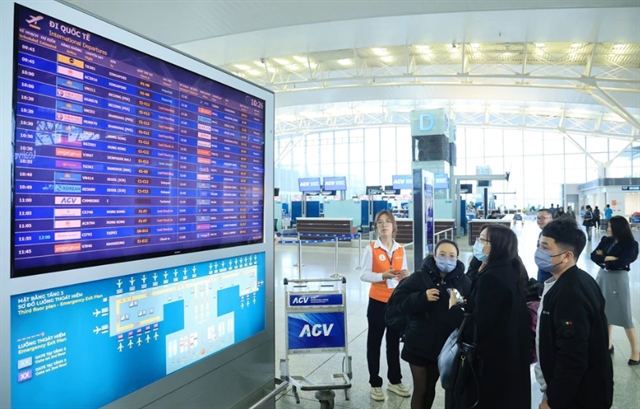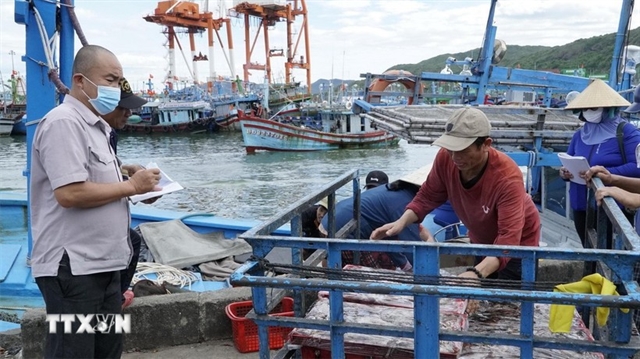 Economy
Economy

.jpg)
|
| Deputy Minister of Agriculture and Rural Development Nguyễn Hoàng Hiệp and Will Mackereth, supply chain director at Nestlé Vietnam, present awards to the winners at the NESCAFÉ Plan Farmer Contest held during the 2019 Việt Nam Coffee Day celebrations in Gia Lai Province. — Photo courtesy of Nestlé |
HCM CITY — Though Việt Nam is the world’s largest producer of robusta coffee, the industry faces several challenges in the country which threaten its long-term development, according to the Ministry of Agriculture and Rural Development.
The quality of Vietnamese coffee is still modest as most farmers use traditional methods rather than modern technology, Dr Nguyễn Đỗ Anh Tuấn, director general of the ministry’s International Cooperation Department, said.
Ageing plants have also affected coffee output and quality, he said.
Global coffee prices have dropped by 40 per cent since 2010, and people have cut investment in coffee farming, resulting in a fall in output, he added.
Lương Văn Tự, chairman of the Việt Nam Coffee and Cocoa Association, said the 2019-20 crop is likely to see output fall by 20 per cent.
Since 2011, Nestlé has been proactive in presenting solutions and undertaking concrete activities to support the sustainable development of the Vietnamese coffee industry via its NESCAFÉ Plan.
The global NESCAFÉ Plan initiative has been deployed by Nestlé since 2010 in more than 10 countries to bring sustainable value to coffee growers, communities and the planet.
The project is also a testament to Nestlé’s commitment to creating shared values in the coffee value chain. Of all the countries, NESCAFÉ Plan is seen as reaping the greatest success in Việt Nam.
So far, the project has distributed 36 million high-yield and diseases-resistant coffee saplings to farmers and helped rejuvenate over 36,000ha of aged coffee areas in the Central Highlands.
It has also provided training to over 230,000 coffee famers in best practices to improve bean quality and ensure sustainable farming and helped over 21,000 farmers achieve 4C international certification and increase their incomes by 30 per cent.
The project also helps protect the environment by reducing water use by 40 per cent and fertiliser and pesticide use by over 20 per cent.
Will Mackereth, supply chain director at Nestlé Vietnam, said one of the things NESCAFÉ Plan does is help farmers reduce the cost of inputs. This might be in the form of water management or agrochemical, pesticide and herbicide use.
“We are working with farmers to ensure they have a business mindset so that they are looking to optimise costs and the quality of the products. And we help them downstream by working on innovation, branding and product terms to ensure we can get the best value for the coffee throughout the supply chain.
“We are proud of what NESCAFÉ Plan has done to help the farmers achieve sustainable livelihoods by reducing the cost of inputs by intercropping with other crops like pepper, avocado and durian. This means that they can be more resilient so that if the coffee prices are low as they are toda,y they still have a good income from other product streams, but also that the cost of coffee production in Việt Nam is extremely efficient and extremely competitive.
“So we help keep that as viable as possible for farmers and downstream we try and get the best possible return we can for the coffee to ensure the sustainability of coffee here in Việt Nam in the long term.
“We see a lot of improvements in farmer livelihoods and coffee quality.”
Nguyễn Đức Huề, a farmer in Ia Hrung Commune, Ia Grai District, Gia Lai Province, who participated in NESCAFÉ Plan in 2014, said his coffee productivity has increased sharply to five tonnes per hectare on average thanks to better farming practices.
He started intercropping his 4ha coffee plantation with avocado in 2016 and now harvests the fruits.
Tự said: “The NESCAFÉ Plan project has contributed positively in supporting farmers even in the time of market uncertainty.”
The productivity of coffee farms participating in the project is 4.5-5 tonnes per hectare, much higher than the country’s average of 2.6 tonnes, he said.
“The project contributes greatly to the coffee sector’s target of replacing 130,000 hectare of ageing coffee out of a total coffee area of 650,000 hectare.”
Nestlé has also organised activities to create opportunities for farmers from various locations to meet and exchange experiences and improve their knowledge of sustainable agricultural practices.
It recently organised the NESCAFÉ Plan Farmer Contest as part of the 2019 Việt Nam Coffee Day celebrated in the Central Highlands province of Gia Lai from December 7 to 11.
The competition attracted the participation of 90 outstanding coffee farmers from Đắk Lắk, Đắk Nông, Gia Lai and Lâm Đồng.
Mackereth said: “2020 will mark the 10th anniversary of NESCAFÉ Plan Vietnam and we expect many more such activities.”
Nestlé is the biggest buyer of coffee in Việt Nam, buying US$700 million worth a year. — VNS